Walking The Line
by Mike Tucker
Reprinted from "Crown Jewels of the Wire", February 1989, page 6
BIDDLE AND BITS
This is an account of my very first threadless insulator hunting trip in mid-April in Wyoming.
l am just beginning to collect threadless and am very much
interested in searching for them. I went with two beginners in the hobby, Mike
Cerizo and Tim Morrow. This is an account of the best day of our trip taken from
my book, In Search of Threadless.
SATURDAY, April 16, 1988
After a large and filling breakfast at a pancake house in Laramie, Wyoming,
we head out to the roadbed all fired up for threadless. Stopping at a local gas
station en-route, we ask the man in charge if anyone has walked the bed for
insulators and he says not for a long time -- years.
We head down the gravel road
off the main highway toward the U.P.R.R. roadbed and notice many antelope
observing us. We finally get to the roadbed and see the product of many decades
of abandonment -- overgrowth by sagebrush. Remembering the previous cold day we
experienced in the Sherman Mountains, we find ourselves overdressed. As we walk
this desert and sagebrush stretch, we strip ourselves of excess clothing to
adapt to the 80-85 degree temperature.
Arming ourselves with the necessary
equipment, we begin our trek on this segment of roadbed. Tim and Cerizo
"hit" one side while I hit the other. There are many areas with
whiskey bottle chips -- probably from the era of the Irish railroad workers. As
I got about one half to three quarters of a mile down the roadbed, I start
letting out the traditional, Indian-like war whoop as I pick up a cobalt piece
embossed U.P.R.
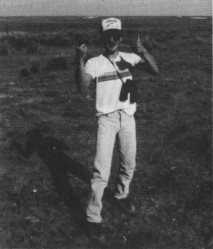
Mike Cerizo giving a "thumbs up" after making a find
Afterward Cerizo joins me in walking the same side and within fifteen minutes of my find, Mike
Cerizo finds a relatively whole Biddle, only three chips out of the skirt on the
back. It displays mint on the Mulford and Biddle side. The traditional war
whoops of celebration are again released.
We walk several miles along the old
roadbed which is decorated by a barbed wire fencerow for about a mile. We picked
up several CD 731 No Name McKee pieces on our walk. It is about a mile before we find our first pole stump which was sunk in a creek bed.
After about another mile, we stumble upon a myriad of glass pieces and junk,
later finding out from talking to ranchers in the area that it was the remains
of an old town site. I found a shiny aqua crown piece to a CD 735 hat there.
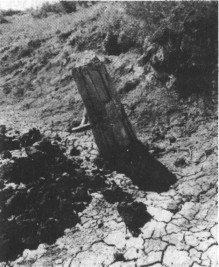
Pole stump found along the roadbed
Walking on farther, Mike and I go through a railroad cut long abandoned. The cut
has been severely eroded by spring melts and looks like a waterfall. Looking
down from the bank above into the cut, we can see a rail which has sunk at least
10 feet due to water erosion. On the other side of the cut, beyond the falls,
was a large pond and on scanning it, we discovered the Union Pacific had run
their tracks right down the middle of where this pond is. We saw the roadbed
emerging from it and curving to the south at the far end of the pond. At this
point, I wondered if any collectors had gone this far and if they had, whether
they had found any insulators where the pond was.
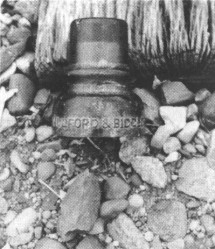
Our Biddle
Having walked about four miles
or more from the gravel road, we decided to go on. We went ahead and traversed
the perimeter of the pond and pressed on for another mile and a half. We found
another area of presumed habitation, for we found many boards and nails lying
around. As well, we found the remains of some type of wooden building, the walls
of which had fallen in. Not far from this, we found an old wooden wagon. Within
a stone's throw from this town site, I found three early threaded insulators --
a
CD 127, 126.3 and a CD 133 Brookfield, all laying in a depression in the soil and etched
from the desert alkali.
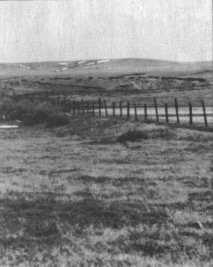
Fence row following roadbed going through a cut in the distance
The walk back to the car was a long one, but we had a
jewel to show for our efforts -- a blue-aqua Mulford and Biddle in near mint condition, a couple of Biddle pieces and numerous No Name
McKee fragments.
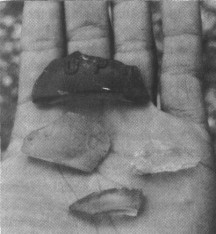
Biddle and bits
I would highly recommend visiting the old roadbeds. As well as
having the chance of finding a Biddle, Chester or McKee, it was a highly
educational experience. Finding remnants of old railroad towns and discovering
relics of history, seeing nature on remote stretches -- whether it be hearing
the buzzing of rattlesnakes, seeing a prairie dog poking its head from its
burrow, finding a shed pair of antelope horns or seeing a jackrabbit fleeing
from you in a series of leaps --- 1 guarantee it will be a rewarding and
memorable experience whether you find any insulators or not.
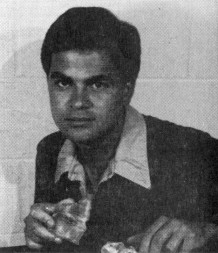
Author, Mike Tucker, displaying some
of the threadless pieces found
| 